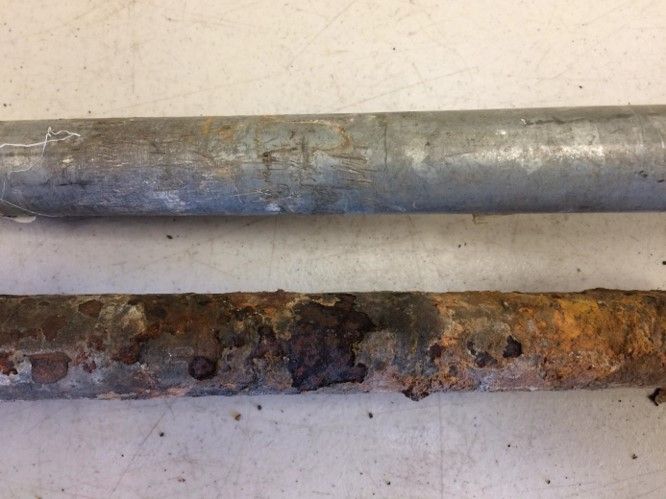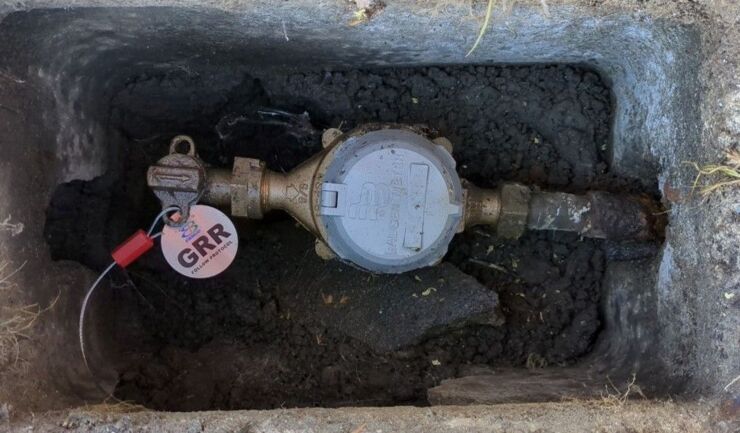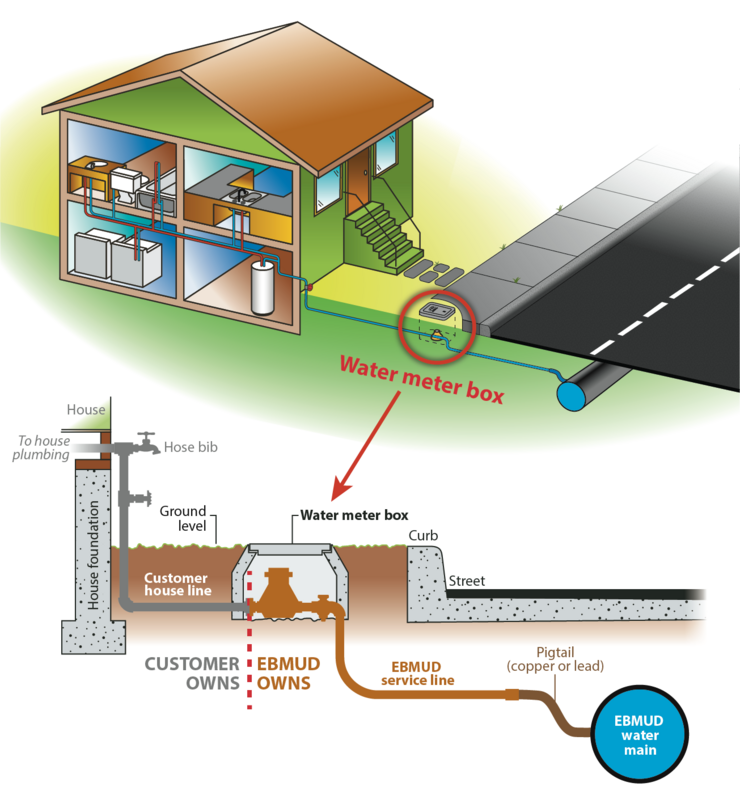New And Old Galvanized Pipes
Yes. Until about 1960, EBMUD periodically installed galvanized iron or steel service lines. EBMUD no longer installs galvanized pipes, and we remove them whenever we find them during regular work such as fixing leaks or breaks in our water mains.
Because galvanized lines are rigid, they were connected to the water main with a short, flexible pipe called a “pigtail” or “gooseneck”. Before 1928, pigtails in our service area were typically made of lead; after 1928 only copper pigtails were used. The only exception is during World War II when copper was unavailable. Between 1942 and 1945, if pigtails were used on galvanized services, they were made of lead.
We are working to remove the remaining galvanized iron pipes that are connected to the mains with lead pigtails. As of early 2025, there are about 200 galvanized service lines with lead pigtails in service, and about 800 galvanized service lines with copper pigtails. To put that in context, EBMUD has about 385,000 service lines. So less than 0.3 percent of our service lines are galvanized iron pipe. We expect to have all galvanized iron pipes with lead pigtails removed by 2027.
Galvanized pipes can last many years, but eventually the zinc coating will be gone. Once the coating is gone, the iron will rust, corrosion deposits can build up inside the pipe, and they will leak. Iron pipes do not corrode uniformly; discrete mounds can form inside the pipes called tubercles which can block water flow. Old, corroded galvanized pipes can cause low water pressure and discolored water.
Although the galvanizing coating is mostly zinc, contaminants such as lead and cadmium can be present in the coating. In addition, if there was a lead pipe connected to the galvanized pipe, scales containing lead can form on the interior walls of the galvanized pipes. These lead-containing scales can become dislodged or dissolve over time, imparting lead into the water.
Most homes in the East Bay built after 1960 don't have galvanized pipes. You can check your plumbing materials yourself, or you can have a plumber inspect them. Get a magnet and see if it sticks to the pipe – a magnet will only stick to iron pipes; copper, plastic, and lead will not hold a magnet. If the magnet does not stick, use a screwdriver, coin, key, or other hard material to scratch the surface of the pipe, removing any paint or dirt. Plastic will obviously look like plastic, it is generally white, gray, black, or blue. Metallic material will either look like copper (like a penny) or it will be gray in color. Galvanized iron pipe will remain a dull gray where it was scratched; lead is softer and will be a shiny silver color when scratched.
In some situations, lead can be released from the lead pipe, and lead-containing scales can form on the interior surface of galvanized iron pipes. Over time, particles from the lead scales can come loose and enter the drinking water. In some cities (e.g., Washington DC), high levels of lead were measured inside homes with galvanized iron pipes even after the lead service lines had been removed. This lead-release from galvanized iron pipes has not been observed in EBMUD’s system.
Historically, EBMUD had about 7,500 lead service lines. All lead service lines have been removed. However, in accordance with EPA regulations, we checked these former lead pipe locations to see if there’s galvanized iron pipe on the customers’ side. We have notifed all customers where we found this situation (galvanized house line formerly downstream of an EBMUD lead service line). These locations are shown on our service line inventory map.
Probably not, but it should be tested. We have collected hundreds of water samples from galvanized iron pipes downstream of lead components, and the lead concentrations are very low (90% of all results were less than 1 ppb). The only way to know for sure is to have the water tested. For more information, please contact customer service at 866-403-2683 or customerservice@ebmud.com.
Many faucets and valves have brass parts. Brass is an alloy made mostly of copper and zinc, but it can have small amounts of other metals. Starting in 1986, faucets were required to be “lead free”, however the definition of “lead free” at the time was less than 8% lead by weight. That's still enough lead to cause problems. Since 2010 faucets sold in California can have no more than 0.25% lead.
Copper pipes in residential buildings are often joined together with solder. Before 1986, most solder was “50/50”, which means 50% lead and 50% tin. Newer solder is lead-free (no more than 0.2% lead). There is no way to tell by looking at it whether solder contains lead. There are inexpensive lead test kits involving wipes or swabs that can be used to confirm if a material contains lead.
You cannot taste or smell lead, the only way to know is to have it tested. EBMUD offers a free lead test for our customers (one per year) upon request. Call us at 866-403-2683 or email us at customerservice@ebmud.com to arrange for a sample kit and instructions.
No, EBMUD does not currently have any lead service lines. Between 1942 and 1945 EBMUD installed about 7,500 lead service lines when copper and steel were in short supply due to the war. Starting in 1945, EBMUD began removing them. By 1970, half of them had been removed, and by 2000 97% had been removed. After intensive searches through old hand-written records and many field investigations, today all lead service lines have been removed throughout the service area.
Prior to 1928, EBMUD connected galvanized service lines to the water mains with short, malleable connectors made of lead. These are called “pigtails” or "goosenecks" due to their shape. Historically, EBMUD may have had as many as 20,000 galvanized service lines. As of early 2025, there are about 200 galvanized service lines with lead pigtails still in service. We are removing these pigtails, along with the associated galvanized pipes, and we anticipate completing this work by 2027. Each time we remove a lead pigtail, we inform the customer, provide a pitcher filter to ensure they are not exposed to lead in their water, and test their water once the work is complete to make sure it’s safe to drink. These galvanzied lines with lead fittings are included in the District's inventory.
Test. The best way to find out if lead is present is to test the water. EBMUD offers a free lead test for every customer each year. Call us at 866-403-2683 or email us at customerservice@ebmud.com to arrange for a sample kit and instructions. We will ask you to allow the water to sit unused in the pipes for at least six hours before collecting a sample, and then we’ll analyze the water and send you the results. You should test the faucet that you use most often for drinking water. If you decide to have someone else test your water for lead, make sure they are certified by the state of California to perform the analysis.
Flush the water. If lead is present, the highest concentration usually will occur when water sits unused for a long period of time. The easiest thing to do is flush this water out. If the source of lead is the faucet, you may only need to flush for 30 seconds or so. If the source of lead is the solder in the copper pipes in the home, you might need to flush for a few minutes to bring in fresh water from the pipe in the street. Note: At one gallon per minute, a 2-minute flush is enough for a 50-foot service line. You can wash dishes, do laundry, take a shower, or use the water in some other way, and then draw water for drinking. You can keep a pitcher of well-flushed water in the refrigerator for drinking.
Clean the screens (also known as aerators) on the faucets regularly. Small particles containing lead can become stuck there and should be removed regularly. Replace the aerators periodically, especially when they are visibly clogged.
Consider a filter. There are water filters that you can attach to your faucet, and filters contained inside water pitchers, that effectively remove lead from water up to 150 ppb. If you use a filter, make sure that it’s certified for lead removal (it should say “NSF/ANSI Standard 53” on the package) and be sure to follow the instructions about replacing the cartridges on time. This link contains information about the NSF certification process for lead removal filters: Listing Category Search Page Results | NSF International. Boiling water does not remove lead. EPA has a guide to help figure out if a filter is certified for lead removal.
GRR means Galvanized Requiring Replacement. This is the term EPA uses to indicate a galvanized pipe that is, or was, downstream of a lead service line. Studies indicate that under some conditons, lead can be released from the lead pipe and attach to the galvanized pipe, forming a scale inside the pipe. Later, after the lead pipe is removed, this lead-containing scale can release lead into the water. This lead capture-and-release situation does not always occur with galvanized pipes, and has not been observed in EBMUD water. Nonetheless, have identified all of our GRRs and informed these customers of the situation, in accordance with new EPA rules. The locations of the GRRs are included in the service line inventory.
When we confirm the presence of a GRR, we attach a stainless steel tag inside the meter box. This tag is stamped with the EBMUD logo and says "GRR Follow Protocol".

The GRR tag means that there used to be an EBMUD lead service line attached to this customer's galvanized service line. The lead service line has been removed. However, if the galvanized line is disturbed, it should be thoroughly flushed when the work is complete, bottled water or filtered water should be used for drinking and cooking until the water is tested for lead and shown to be safe. Call us at 866-403-2683 to arrange for a free lead test.
Water service line inspections
In 2023 - 2024, EBMUD’s contractor inspected approximately 10,000 water service lines connecting water meters to homes and businesses as required by new federal regulations. These inspections were done at locations where our records indicate the water meter was once connected to an EBMUD service line made of lead. EBMUD removed all lead service lines years ago and our water quality testing has verified that no lead is in water supplied by EBMUD. The flyer below was created to help explain the inspection process and answer customers' questions about these inspections.

Fact Sheets
| Document | Type | Size |
|---|---|---|
| Water Service Line Inspection Flyer | <1 MB |